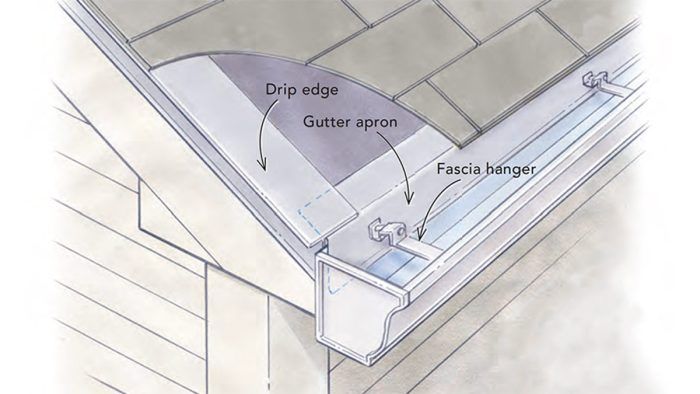Do I Need a Gutter Apron?
Learn why installing a gutter apron is crucial for protecting your roof and fascia from rot and water damage.

I’d like to install seamless gutters, and I now have two bids on the project. The more expensive estimate includes the installation of an “apron.” What is a gutter apron, and do I need it?
—Bob Welle, Zimmerman, Minn.
Mark Petersen, tech editor, replies: Yes, you do need a gutter apron. I owned a seamless gutter company for many years and hung miles and miles of gutters, and I never installed gutters without them. Gutter apron is just another name for a type of flashing that is tucked up under the shingles and over the back portion of the gutter. Just like standard drip-edge flashing, a gutter apron protects the fascia or subfascia and roof decking from rot due to repeated saturation. This protection is especially important on eaves with gutters because gutters create a trough that will cause rainwater to splash back toward the house as it falls from the sky and dumps in off the roof. Also, snow and ice can accumulate in the gutters, which can wreak havoc when it melts. Some roofers will leave off the standard drip-edge flashing on the eaves that they know will receive gutters with the understanding that the Gutter Guys (that was the name of my company) will install a gutter apron. A gutter apron is crucial in these cases because water will be splashing back directly onto unprotected wood on the decking and the fascia/subfascia.
Another less crucial role that a gutter apron serves is to prevent water from hugging the underneath surface of the bottom row of shingles (via surface tension), rolling back toward the house, and falling to the ground behind the gutter. This seems like an unlikely scenario, but I’ve seen it happen. While the amount of water is negligible, if it happens long enough, the constant dripping (often caused by morning dew) can create water lines in landscaping and can stain and erode sidewalks and driveways.
If there was drip edge already installed on the eave side of the roof, we would use that drip edge as the apron and tuck the back side of the gutter up under it. In a perfect world, the apron would be installed under the self-adhering underlayment, but if the underlayment has already been installed, which is usually the case, it’s not possible to peel it back up to slide the apron under it, so the top flange of the apron will have to sit on top of the underlayment. Whenever possible, however, it’s best to tuck the apron under the drip edge coming down a rake or gable.
The way we installed a gutter apron was to hang the gutters in their permanent position with smaller screws before installing the apron. The fascia hangers would be fastened through the apron into the subfascia. Depending on the roofing materials used, the pitch of the roof, and how long the roofers let the shingles overhang, installing a gutter apron can often take longer to install than the actual gutter itself. So while it is necessary, it does cost extra.
Drawing: Dan Thornton
From Fine Homebuilding #319
RELATED STORIES
Fine Homebuilding Recommended Products
Fine Homebuilding receives a commission for items purchased through links on this site, including Amazon Associates and other affiliate advertising programs.

Peel & Stick Underlayment

Roofing Gun

Flashing Boot Repair





























